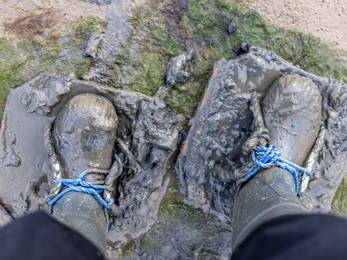As I stood on the sea wall at Farlington Marshes Nature Reserve, as the sun began to set on December 1st last year, as well as feeling a huge sense of relief and elation at what we’d just done, I couldn’t help also thinking back to the start of 2021 and being pretty overwhelmed with how far our project had come in just eleven months.
At the start of the year, as Covid-19 raged around us and new lockdowns were introduced, we were putting the final stages together on our plans for the Solent Seagrass Project and hoping that our partners, Boskalis Westminster Ltd would be happy and give the go-ahead. They were, and so on April 1st we were suddenly faced with the very real challenge of two years to demonstrate that we could research and develop the skills we’d need to start the process of restoring one of the Solent’s most important habitats – seagrass meadows.
A frantic summer followed, surveying and monitoring our local seagrass meadows to see which ones were growing and flowering well (seagrasses are the only marine flowering plants!) and to find suitable sites close to existing meadows, where we could set up a pilot trial.
At the same time, we were finding out about the skills and equipment we’d need. I visited the Ocean Conservation Trust to help with one of their seagrass restorations near Plymouth and we also forged links with Project Seagrass and the University of Swansea. Everyone has been helpful and supportive in sharing ideas and experience.
In late summer, we began working with our academic partners at the University of Portsmouth (UoP), to plan and carry out our first trials.
Bad weather in August, perhaps not helped by the sewage releases which happened at the same time, had affected one of our potential seed-donor sites, so we had retreated to the comparative calm of Langstone Harbour where the seagrass was still flowering and setting seed. Working on the mud in Langstone presented us with all sorts of challenges, from safety to the simple problem of getting about and trying not to cause too much disturbance, but with the aid of “mud pattens”, traditional wooden mud-walking gear, tied on to our wellies and dragging body boards behind us, we were able to start collecting seagrass seed.
We must have been quite a sight, for anyone looking out over the mudflats at that time as groups of us lay on the mud, picking through the seagrass, looking for the special flowering shoots called "spathes”, which contained the developing seeds. We couldn’t have done it without the fantastic help we got from UoP students, and volunteers from Boskalis Westminster and our own Marine Champions, who all put in the hours out on the mud.
By the end of October we estimated we’d collected 25-30,000 seeds, all being held in the aquarium tanks at the UoP Institute of Marine Science as the seeds matured and were released from the decaying spathes, a process rather grimly known as, “rotting out”.











